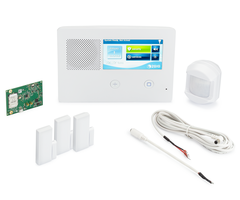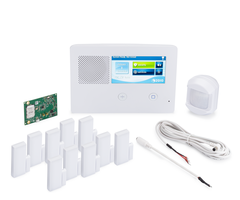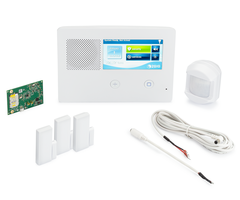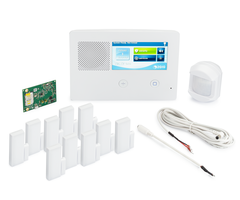Installing the Cell Module in a 2GIG GC2e
Related Products




Related Categories
Description
In this video, Michael from Alarm Grid shows you how to install a cellular communicator inside a 2GIG GC2e. Remember that you must always power down the system completely before attempting to add or remove a cellular communicator. The 2GIG GC2e is powered down by opening up the panel, disconnecting its backup battery, and unplugging its power transformer from an AC outlet.
The cellular communicator is what allows a 2GIG GC2e System to communicate with the Alarm.com servers for monitoring service. The GC2e does not have a built-in WIFI card, so cellular connectivity is the only way it can send and receive signals. Alarm Grid recommends installing an LTE communicator for the 2GIG GC2e. Examples of compatible LTE communicators for the 2GIG GC2e include the 2GIG LTEA-A-GC2 AT&T LTE Communicator and the 2GIG LTEV1-A-GC2 Verizon LTE Communicator.
Once you have the cellular communicator installed, you must then activate it for alarm monitoring service. Your monitoring plan will need to include cellular connectivity. Examples of compatible alarm monitoring plans include the Alarm Grid Gold Plan and the Alarm Grid Cell Only Plan. Depending on your monitoring plan, your GC2e will be able to send signals to a central monitoring station and/or your phone or email address. Any signals will pass through the Alarm.com servers first. Without Alarm.com connectivity, monitoring service is impossible for a 2GIG GC2e.
Being able to control your system remotely from Alarm.com is another important feature, as this is how you can operate the system while you are away from your home or business. Alarm.com allows you to arm and disarm your system, check current system status, control programmed Z-Wave devices, view the live feed for Alarm.com Security Cameras, and more. Alarm.com can be accessed from a web browser or remotely using the Alarm.com Mobile App on an Android or iOS device.
https://www.alarmgrid.com/faq/how-do-i-install-the-cell-module-in-a-2gig-gc2e
http://alrm.gd/get-monitored
Transcript
[ALARM GRID SOUND BRAND] Just a quick note, in this video, I'm about to show you how to install a cell module inside of a 2GIG GC2e alarm system. And when I went to do this, we actually had the system powered on. And I already had the cell module installed, but at the spur of the moment, I decided to take it out so you could see the port. And then I put it back in without powering down the panel. That's a big no-no. This unfortunately fried our 2GIG GC2e system, and now we are going to have to replace it with the new one. So just a warning for all of you, a serious warning, make sure to power down your system fully before you ever install a cellular communicator. You have to disconnect the backup battery and disconnect the transformer. Make sure it's fully powered down, then install the cellular communicator. Don't do what I did. Make sure your system doesn't break. Hi, DYIers. This is Michael from Alarm Grid, and today, I'm going to show you how to install a cellular communicator inside a 2GIG GC2e security system. Now we actually have a cellular communicator already installed in the system, but I'm going to be opening it up and showing you how it is installed. But before I do that, I'm going to talk about the purpose of a cellular communicator. This system does not have built in Wi-Fi, so it relies on a cellular communicator for sending out signals such as alarm signals, or if Z-Wave transmission needs to go through, it's going to communicate through cellular communication. And then it allows it to communicate with the alarm.com servers, which can then forward alerts to the end user and/or a central monitoring station, depending on what type of monitoring plan you have. And you're going to want to have a monitoring plan with this. Otherwise, it will just be a local sounder, and the cellular communicator will not be activated. And it will not work. And if you're adding a cellular communicator to the system, we recommend getting an LTE model. LTE networks are expected to be kept in service for a very, very long time. And with the 3G/CDMA sunsets, those older communicators won't work anymore. So make sure you get an LTE communicator. The GC2e actually uses the same cellular communicators as what you would use on to 2GIG Go Control, GC2, but like I said, make sure you get an LTE model. We have AT&T and Verizon ones for sale on our site. Just use whichever network works better in your area. So make sure to go LTE, but the process for installing the communicator is pretty simple. You have to open a panel, which I'm going to demonstrate now. So you just take this front plate off. You kind of just get your fingernail under there and pull it off. It pops off, and then the tricky part is taking this off. You see this unlock before opening. We didn't have to do anything with that, but if yours is locked you can release it there, and that's how you would get inside it. So you just kind of stick your flathead screwdriver in there to where it comes out. And it looks like we've got the first one-- didn't I? OK, we'll do that, and let's see. Nope, didn't get it quite yet. We just got to get this one in there, and actually, I think I missed the other one as well, so we're just going to go and do that. There we go. You got the tamper, cover so we know it's open. [CHUCKLES] And you just kind of get it in there. There we go. So here's the inside of the 2GIG GC2e, and this right here, this portion, is the cellular communicator. And it actually has two screws that we connect in there. It has a port at the bottom. You know what? I'm just going to go and show you what it looks like actually. So bear with me one second. Gotta flip our screwdriver around real quick, and so it's a phillips head. It's magic, like that. And if I undo these screws here and I can show you what it looks like, we'll speed this up for you. OK, so we undid our screws to be able to remove the cellular-- [GLASS BREAK SOUND] To be able to remove-- (SLOW MOTION AND SOUND EFFECT) the cellular communicator. And as you can see, it has this nice port. That's the male section. That's the female section right there. And you can just go, and plug it in. You just make sure it clicks into place. There you go. See, it locks into place like that. Now your communicator will likely also have an antenna. Some use multiple antenna ports. This one only has one, and you can see the antenna. We'll bring it out here for a second. Here's the other end of the antenna, and you just want to slide it through the backplate. And stick it somewhere where it can get good cell signal. You don't stick it in here, which although that fits really nicely, that's not the antenna port. You just want to slide through the backplate like so, and so you just kind of click it into the port. And then you can go and do the screws, which I'll do right now. And again, we'll speed this up. OK, now we have our screws inserted, and the communicator is secured. And we're ready to go for closing the system. And by the way, just to point out, this is actually an older 3G model that's not activated, but any communicator is going to follow the same process. Like we said, make sure to get an LTE communicator. If you're looking to get a new communicator for your GC2e security system, we have some listed on our site. So then you can just close it up. You just kind of pop it back in to place here, and there we go. We're looking good, and we can just pop the front cover back on. And we cut power to the system, but we'll cross that bridge next time. [LAUGHS] Anyway, that's how you install a cellular communicator inside a 2GIG GC2e security system. If you found this video helpful, make sure to give it a thumbs up below to like this video. And if you found this video helpful, remember to subscribe to our channel to get updates on future videos. And if you have any questions about the 2GIG GC2e, or about alarm monitoring service, or if you're interested in activating a cellular communicator for a GC2e for monitoring service, or any other system that you might want to use, send us email at support@alarmgrid.com. And we'd be happy to help you out. Hope you enjoyed the video. Thank you.
- Uploaded

